| Article ID | Journal | Published Year | Pages | File Type |
|---|---|---|---|---|
| 10429454 | Biosensors and Bioelectronics | 2011 | 7 Pages |
Abstract
Molecular beacon (MB) is especially suited for detection of single nucleotide polymorphism (SNP), and the type of MB immobilized on the surface of microarray in particular, may detect multi-sample and multi-locus. However, the majority of MB needs to be labeled with fluorescence and quenching molecules on the two ends of the probe, and observed the reaction of fluorescence or complicated electrochemical signal produced hybridization of MB and target sequence by complex and expensive instruments. The “molecular beacon” and microarray designed appropriately in our study can produce visible light response signal induced by amplification effect of enzymatic color, and are avoided with the marker of fluorescence and quenching molecules and expensive instruments. The “molecular beacon” without fluorescence and quenching molecules is entitled as “hairpin DNA probe” by us for only the “hairpin” structure of traditional molecular beacon is adopted. The merits of two techniques, molecular beacon and amplification effect of enzymatic color, are successfully combined, and the technique is simple, sensitive and specific, to detect and compare the methylenetetrahydrofolate reductase (MTHFR) Gene C677T mutation of subjects between coronary heart disease (CHD) and control group. The results showed that MTHFR Gene C677T polymorphism is an independent risk factor for CHD.
Related Topics
Physical Sciences and Engineering
Chemistry
Analytical Chemistry
Authors
Qinghai Chen, Yue Sun, Linqun Zhang, Kun Deng, Han xia, Hua Xing, Yang Xiang, Boli Ran, Mohan Zhang, Xiaodong Xu, Weiling Fu,
